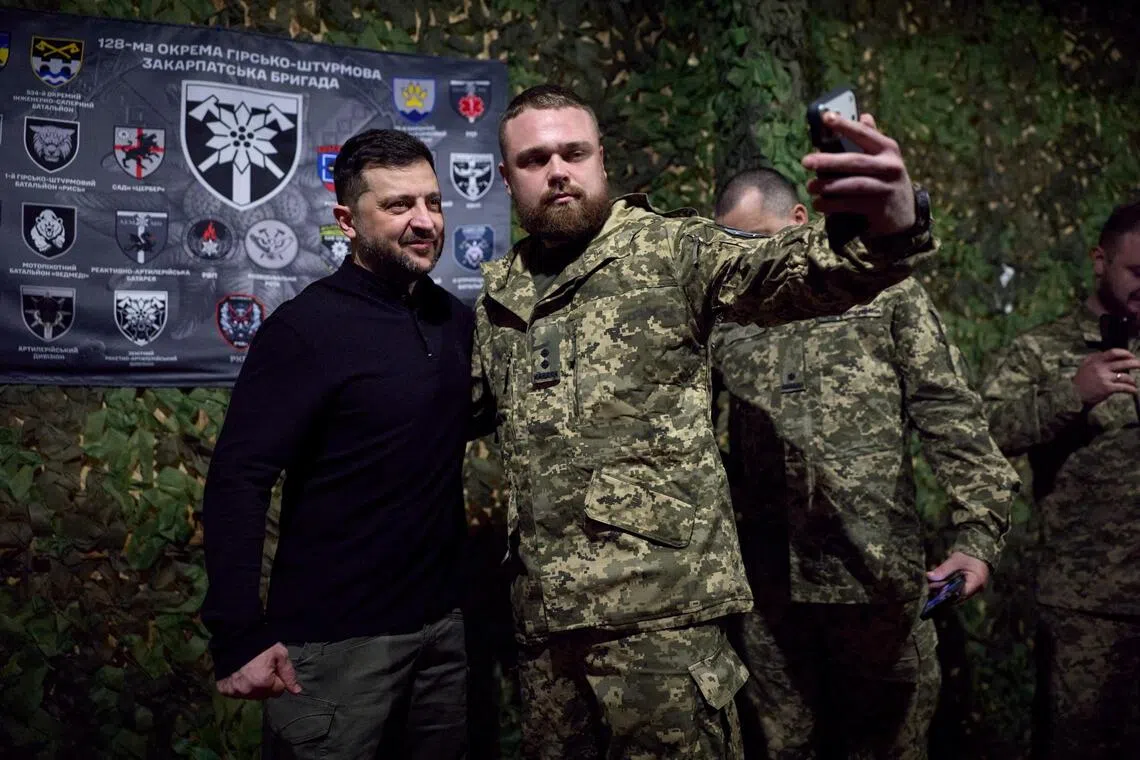Ukraine’s Zelensky visits troops near Zaporizhzhia front as Russian pressure mounts
Sign up now: Get ST's newsletters delivered to your inbox

Ukrainian President Volodymyr Zelensky posing for a photo with a Ukrainian serviceman, as he visits the country's Zaporizhzhia region on Nov 13.
PHOTO: REUTERS
Follow topic:
- Zelensky visited troops near Orikhiv, Zaporizhzhia, calling the situation "one of the most difficult" and crucial for defending the city against Russian advances.
- Ukrainian commander Syrskyi acknowledged a "significantly worsened" situation in parts of Zaporizhzhia, with Russian forces making tactical gains due to Ukraine's manpower shortage.
- Ukraine is countering Russia by targeting its oil infrastructure with drone attacks, including using the new Flamingo missile, impacting Russian refinery capacity.
AI generated
LONDON/KYIV - President Volodymyr Zelensky visited troops near Ukraine’s southeastern front on Nov 13, warning of the need to shore up the lines after losing ground in increasingly high-intensity battles far from Russia’s offensive in the east.
Mr Zelensky, whose government is reeling from a corruption scandal, said the situation near the village of Orikhiv was “one of the most difficult” on a sprawling front and that thwarting Russian forces there was key to shielding the city of Zaporizhzhia.
“This (Zaporizhzhia) is an important city, the enemy certainly wants it. We certainly have to defend it,” he said, awarding medals to troops and discussing ways to strengthen the lines.
Neither side has made any major breakthroughs on the battlefield since the first year of Russia’s 2022 invasion. But Moscow’s forces, which control 19 per cent of Ukraine, have been on the offensive since late 2023 and have gradually edged forward.
At a time when Russian forces are closing in on the capture of the city of Pokrovsk in the east and bearing down on Kupiansk to the north-east, the newly-mounting pressure in the south-east is a worry for Ukraine and its allies.
With unusual candour, top Ukrainian military commander Oleksandr Syrskyi said earlier this week that the situation had “significantly worsened” in parts of the Zaporizhzhia region.
Roughly half of all Russia’s front-line gains in the last two months have come around the southeastern settlements of Huliapole and Velyka Novosilka, said Mr Konrad Muzyka, director of the Rochan military consultancy in Poland.
“Although this is not the main Russian effort, Ukraine’s shortage of manpower has allowed Russian forces to make tactically significant advances,” he said.
The push west of Velyka Novosilka could potentially threaten Huliapole from the north, he added.
“If Ukraine does not address these gaps, Russian forces may push further west - not only moving closer to Zaporizhzhia, but also risking the isolation of Ukrainian units in the south,” he said.
Mr Pavlo Palisa, a military official in the president’s office, said Russian forces were probing for weak points and using foggy weather conditions to try to bypass Ukrainian positions in the south-east.
Flamingo fired
Mr Zelensky met soldiers in a bunker, held talks with military commanders and laid flowers for deceased soldiers on his trip. He said he discussed decisions needed to strengthen Ukrainian defences, including staffing and equipment.
The visit comes as Mr Zelensky and his government are trying to extinguish the fallout from a major corruption scandal Russia’s bombing of power stations.
Ukraine has tried to increase the pain on Russia, in recent months, using drones to target its oil infrastructure
The military said it hit an oil terminal in occupied Crimea, an oil depot in occupied Zaporizhzhia region and other military targets overnight. It said it used weapons including the Flamingo, a new Ukrainian-made ground-launched cruise missile it says has a range of thousands of kilometres.
At the height of the strikes between August and October, attacks and planned maintenance took 20 per cent of Russia’s refinery capacity offline, Reuters reported earlier, citing calculations based on information from three Russian industry sources. REUTERS

